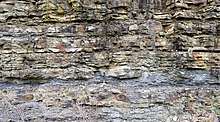Hale Formation
The Hale Formation is a geologic formation in northern Arkansas that dates to the Morrowan Series of the early Pennsylvanian.[3] The Hale Formation has two named members: the Cane Hill and the Prairie Grove Members. The lower member is the Cane Hill, a primarily sandstone and shale interval that unconformably overlies the Mississippian-age Pitkin Formation. The upper member, the Prairie Grove Member, is predominately limestone and conformably underlies the Bloyd Formation.
| Hale Formation Stratigraphic range: Pennsylvanian | |
|---|---|
 Outcrop of the Cane Hill Member of the Hale Formation | |
| Type | Formation |
| Unit of | none |
| Sub-units | Cane Hill Member, Prairie Grove Member |
| Underlies | Bloyd Formation |
| Overlies | Pitkin Formation |
| Thickness | few feet to over 300 feet[1] |
| Lithology | |
| Primary | Limestone, Sandstone |
| Other | Conglomerate, Shale |
| Location | |
| Region | Arkansas |
| Country | United States |
| Type section | |
| Named for | Hale Mountain, Washington County, Arkansas |
| Named by | J.A. Taff[2] |
Nomenclature
Named by J. A. Taff in 1905, the Hale Formation was originally called the "Hale sandstone lentil" of the Morrow Formation after Hale Mountain in Washington County, Arkansas.[2] In the same year, George I. Adams and E. O. Ulrich called it the "Hale sandstone member" of the Morrow Formation. In 1907, Albert Homer Purdue raised the rank to the Hale Formation of the Morrow Group,[4] however, the Morrow Group was later abandoned as a stratigraphic unit in 1961.[5] A stratotype was not designated by J. A. Taff and, as of 2017, no reference section has been designated.
The Cane Hill Member was named after the town of Cane Hill in Washington County, Arkansas in 1953 by Lloyd G. Henbest, who also named its upper member, the Prairie Grove Member, after the town of Prairie Grove, in Washington County, Arkansas.[6] Henbest did not designate a stratotype for either of these members, and as of 2017, neither of them have been designated a reference section.
In the eastern parts of the Ozarks in Arkansas, the Hale Formation becomes undifferentiated with the overlying Bloyd Formation and is called the Witts Springs Formation.
Paleontology
Brachiopods
|
|
Bryozoans
Cephalopods
|
|
Conodonts
|
|
Flora
- Archaeolithophyllum
- A. missouiense[16]
- Asphaltina
- A. cordillerensis[16]
- Eflugelia[16]
- Girvanella[17]
- Stacheoides
- S. spissa[16]
Foraminifera
|
|
References
- McFarland, John David (2004) [1998]. "Stratigraphic summary of Arkansas" (PDF). Arkansas Geological Commission Information Circular. 36: 13–14. Archived from the original (PDF) on 2016-12-21. Retrieved 2018-05-26.
- Taff, J. (1905). "Description of the Tahlequah quadrangle". U.S. Geologic Survey Geologic Atlas of the United States. 122: 2, 3.
- Various Contributors to the Paleobiology Database. "Fossilworks: Gateway to the Paleobiology Database". Archived from the original on 31 July 2014. Retrieved 8 July 2014.
- Adams, George I.; Ulrich, E. O. (1905). "Description of the Fayetteville quadrangle" (PDF). U.S. Geological Survey Geologic Atlas of the United States Folio. 119: 4. Retrieved 1 June 2018.
- Merewether, E. A.; Haley, B. R. (1961). "Geology of Delaware quadrangle, Logan County and vicinity, Arkansas" (PDF). Arkansas Geological and Conservation Commission Information Circular. 20-A: 30. Retrieved 1 June 2018.
- Henbest, L.G. (1953). "Morrow group and lower Atoka formation of Arkansas". American Association of Petroleum Geologists Bulletin. 37 (8): 1935–1953.
- Horowitz, Alan S.; Macurda Jr, D. B. (1977). "Late Mississippian and Early Pennsylvanian blastoids from northeastern Oklahoma and northwestern Arkansas" (PDF). Oklahoma Geological Survey Guidebook. 18: 169–170. Retrieved 31 January 2018.
- N. A. Heim. 2009. Stability of regional brachiopod diversity structure across the Mississippian/Pennsylvanian boundary. Paleobiology 35(3):393
- Henry, Thomas W.; Sutherland, Patrick K. (1977). "Brachiopod biostratigraphy of Morrowan series (Pennsylvanian) in northwestern Arkansas and northeastern Oklahoma" (PDF). Oklahoma Geological Survey Guidebook. 18: 107–115. Retrieved 1 February 2018.
- Horowitz, Alan S. (1977). "Late Mississippian and Early Pennsylvanian bryozoan faunas of Arkansas and Oklahoma: a review" (PDF). Oklahoma Geological Survey Guidebook. 18: 101–105. Retrieved 3 February 2018.
- W. L. Manger and W. B. Saunders. 1980. Lower Pennsylvanian (Morrowan) ammonoids from the North American midcontinent. Palentological Society Memoirs. 10:1-56
- M. Gordon. 1964. Carboniferous Cephalopods of Arkansas. Unitest States Geological Survey Professional Paper. 460:1-322
- Saunders, W. Bruce; Manger, Walter L.; Gordon Jr., Mackenzie (1977). "Upper Mississippian and Lower and Middle Pennsylvanian ammonoid biostratigraphy of northern Arkansas" (PDF). Oklahoma Geological Survey Guidebook. 18: 117–137. Retrieved 1 February 2018.
- Lane, H. Richard (1977). "Morrowan (Early Pennsylvanian) conodonts of northwestern Arkansas and northeastern Oklahoma" (PDF). Oklahoma Geological Survey Guidebook. 18: 177–180. Retrieved 30 January 2018.
- Strimple, Harrell L. (1977). "Chesterian (Upper Mississippian) and Morrowan (Lower Pennsylvanian) crinoids of northeastern Oklahoma and northwestern Arkansas" (PDF). Oklahoma Geological Survey Guidebook. 18: 171–176. Retrieved 30 January 2018.
- Groves, John R. (1983). "Calcareous foraminifers and algae from the type Morrowan (Lower Pennsylvanian) region of northeastern Oklahoma and northwestern Arkansas" (PDF). Oklahoma Geological Survey Bulletin. 133: 65. Retrieved 3 February 2018.
- Brenckle, Paul (1977). "Foraminifers and other calcareous microfossils from Late Chesterian (Mississippian) strata of northern Arkansas" (PDF). Oklahoma Geological Survey Guidebook. 18: 73–87. Retrieved 3 February 2018.
- Nodine-Zeller, Doris E. (1977). "Microfauna from Chesterian (Mississippian) and Morrowan (Pennsylvanian) rocks in Washington County, Arkansas, and Adair and Muskogee Counties, Oklahoma" (PDF). Oklahoma Geological Survey Guidebook. 18: 89–99. Retrieved 3 February 2018.
- Knox, Larry W. (1977). "Morrowan (Lower Pennsylvanian) ostracodes from Arkansas and Oklahoma" (PDF). Oklahoma Geological Survey Guidebook. 18: 139–147. Retrieved 31 January 2018.
- Sohn, I. G. (1977). "Late Mississippian and Early Pennsylvanian ostracoda from northern Arkansas - a preliminary survey" (PDF). Oklahoma Geological Survey Guidebook. 18: 149–159. Retrieved 31 January 2018.
- M. A. Wilson and T. J. Palmer. 1998. The earliest Gastrochaenolites (Early Pennsylvanian, Arkansas, USA): An Upper Paleozoic bivalve boring?. Journal of Paleontology. 72(4):769-772